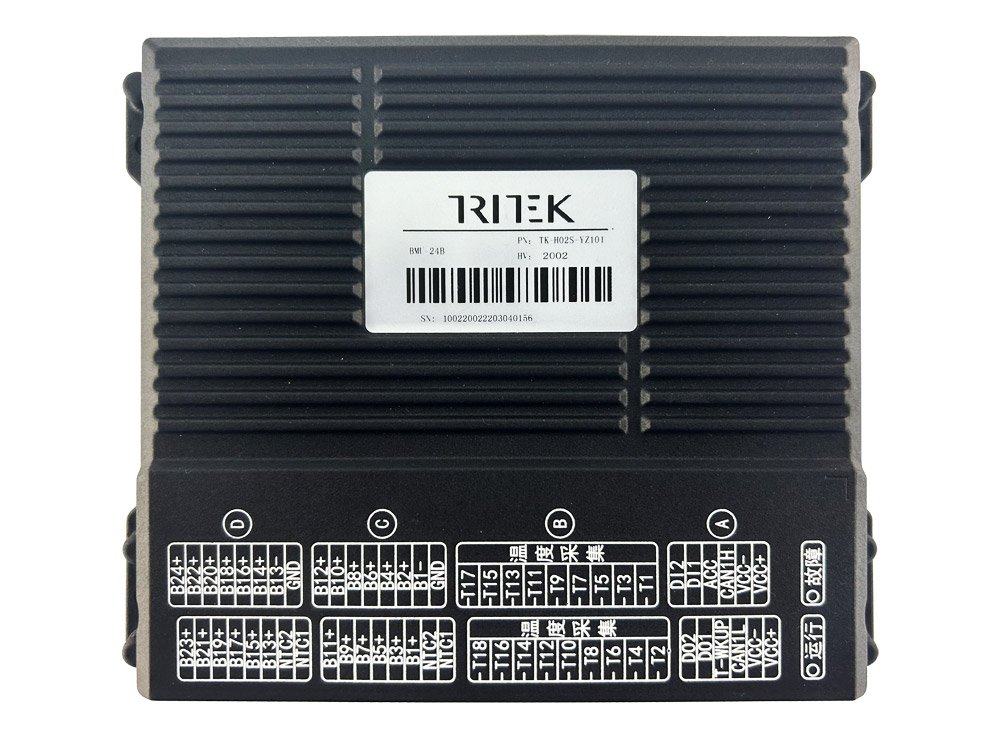Battery Management Systems (BMS) play a crucial role in ensuring the safe and efficient operation of energy storage systems and electric vehicles. With the increasing demand for high voltage applications, customizing BMS to meet specific requirements has become paramount.
In this comprehensive guide, we will explore the intricacies of customizing high voltage BMS, catering to the needs of business buyers looking to enhance their energy storage solutions and electric vehicle fleets.



Table of Contents
ToggleUnderstanding High Voltage BMS
A. Definition and Purpose of High Voltage BMS
A high voltage battery management system (BMS) is a critical system designed to monitor, control, and protect battery cells in energy storage systems and electric vehicles operating within the high voltage range of 100~1500V. Its purpose is to ensure optimal performance, safety, and longevity of battery packs.

B. Features and Functions of High Voltage BMS
High voltage battery management system incorporates features like cell voltage monitoring, current sensing, temperature monitoring, state-of-charge (SOC) estimation, and fault detection. These functions enable efficient battery management, safeguard against risks, and enhance system performance.
C. Importance of High Voltage BMS in Energy Storage System
High voltage battery management systems plays a vital role in optimizing battery performance, ensuring safety, and enhancing system reliability in energy storage systems. It maintains safe operating limits, protects against overcharging and over-discharging, and provides valuable diagnostic capabilities.
Key Parameters and Configuration of BMS
A. Exploring BMS Configuration and Its Role in System Customization
Customizing a high voltage battery management system involves configuring the system to meet specific requirements. This includes selecting the appropriate hardware and software elements tailored to the energy storage system. Customization allows businesses to achieve optimal performance and compatibility.
B. Identifying the Most Important Parameter to Control in BMS
Cell voltage is a crucial parameter to monitor and control in a BMS. Irregularities in cell voltage can lead to imbalances within the battery pack, affecting performance and safety. Monitoring cell voltage enables the battery management system to take corrective measures, such as balancing cell voltages, for optimal performance and longevity.
C. Voltage Measurement and Its Significance in BMS
Voltage measurement is essential for assessing battery pack health and performance. It helps estimate the state-of-charge (SOC), detects faults, and enables cell balancing. Monitoring cell voltages ensures efficient energy management and safe operation.
Components and Modules in BMS
A. Overview of Modules in a BMS
A high voltage battery management system consists of various modules that work together to ensure efficient battery management. These modules include:
Voltage Measurement Module: This module is responsible for measuring the voltages of individual battery cells. It provides crucial data for monitoring the state of charge (SOC) and detecting voltage anomalies.
Current Sensing Module: The current sensing module measures the charging and discharging currents of the battery pack. It helps monitor the power flow and ensures safe operating conditions.
Temperature Monitoring Module: This module monitors the temperature of the battery pack to prevent overheating, which can degrade performance and pose safety risks.
Balancing Module: The balancing module is responsible for equalizing the voltages among individual battery cells. It redistributes charge to maintain uniform cell voltage levels and optimize battery performance.
Communication Module: The communication module enables data exchange between the battery management system and external devices or systems. It allows for real-time monitoring, control, and diagnostics.
B. Voltage Measurement and Cell Monitoring
Voltage measurement is a critical function of a BMS as it provides essential information about the state of the battery pack. The BMS measures the voltages of each individual battery cell using voltage measurement circuits connected to each cell. These measurements are then processed and analyzed by the BMS.
By monitoring cell voltages, the battery management system can determine the SOC, detect voltage anomalies, and ensure the safe operation of the battery pack. Voltage measurements allow the BMS to assess the overall health and performance of the battery cells and take appropriate actions to maintain optimal conditions.
C. Role of Cell Balancing in BMS and Its Impact on Battery Lifespan
Cell balancing is a crucial function performed by the battery management system to ensure the longevity and efficiency of the battery pack. In high voltage applications, imbalances can occur among individual battery cells due to variations in capacity or aging effects. These imbalances can lead to reduced capacity, increased energy loss, and potential safety hazards.
The BMS’s balancing module actively redistributes charge among the battery cells to equalize their voltages. By equalizing cell voltages, cell balancing optimizes the overall performance, extends the battery lifespan, and ensures safe and reliable operation.
Cell balancing is typically achieved through passive or active balancing techniques. Passive balancing relies on resistors to dissipate excess charge, while active balancing utilizes additional circuitry to redistribute charge. The choice of balancing technique depends on the specific requirements of the application and the desired level of balancing precision.
Customizing High Voltage BMS for Specific Applications
A. Choosing the Right BMS Specialization for Different Industries and Applications
Customizing a high voltage battery management system involves selecting the appropriate specialization based on the specific industry and application requirements. Battery management system systems are designed to cater to various sectors, including automotive, industrial, stationary energy storage, and more. Each industry has its unique demands and operating conditions, which require specialized BMS features.
For example, in stationary applications like renewable energy storage systems, BMS systems play a critical role in efficient energy management and prolonged battery lifespan. These systems focus on optimizing power flow, balancing cell voltages, and ensuring the overall health and performance of the battery pack. Customizing high voltage BMS solutions for such applications allows businesses to maximize energy utilization, reduce maintenance costs, and enhance the reliability of their energy storage system.
By working with an expert team like Tritek, companies can harness the benefits of tailored BMS solutions that meet the unique demands of stationary applications.
B. Considerations for Using Lithium Batteries Without BMS
While it is technically possible to use lithium batteries without a BMS, it is highly discouraged due to the inherent risks involved. Lithium-ion batteries are known for their high energy density, making them susceptible to thermal runaway, overcharging, and over-discharging. Without a BMS, these risks significantly increase, potentially leading to battery damage, reduced lifespan, and even safety hazards.
A BMS plays a crucial role in protecting lithium batteries by monitoring and controlling various parameters such as voltage, current, and temperature. It ensures safe charging and discharging operations, prevents overcharging and over-discharging, and maintains the battery within its safe operating area. Additionally, a BMS enables cell balancing, which optimizes battery performance and extends its overall lifespan.
To ensure the safety and longevity of lithium batteries, it is essential to incorporate a BMS into the system. A BMS provides the necessary monitoring, control, and protection functions to ensure the reliable and efficient operation of lithium-ion batteries.
C. BMS Capabilities in Controlling Output Voltage and Preventing Overcharging
A BMS has the capability to control the output voltage of a battery pack, ensuring it remains within safe limits. The battery management system monitors the cell voltages and adjusts the charging or discharging processes to maintain the desired output voltage. This control mechanism helps optimize the battery pack’s performance and ensures compatibility with the intended application.
Moreover, preventing overcharging is one of the critical functions of a BMS. Overcharging occurs when the battery pack receives more charge than it can safely handle, which can lead to battery degradation and safety risks. The battery management system monitors the charging process and implements safeguards to prevent overcharging. It may control the charging current, terminate charging when the battery reaches its maximum capacity, or take corrective actions to balance cell voltages and prevent overcharging in individual cells.
By controlling the output voltage and preventing overcharging, a BMS safeguards the battery pack, enhances its lifespan, and ensures the safe operation of high voltage applications.
Safety and Protection in High Voltage BMS
A. Importance of Short Circuit Protection and Thermal Management in High Voltage BMS
Short circuit protection and thermal management are crucial aspects of ensuring safety in high voltage BMS.
Short circuit protection safeguards the battery pack and electronics from damage caused by unintended low-resistance connections. Measures like fuses and circuit breakers prevent short circuits, protecting the cells and the system.
Thermal management regulates battery temperature within safe limits. Temperature sensors, cooling systems, and insulation prevent overheating, maintaining battery performance and lifespan.
B. Ensuring Safe Operation and Preventing Over-Discharge in BMS
Safe operation and preventing over-discharge are vital for high voltage battery systems. A BMS monitors state of charge (SOC) to prevent excessive discharge, protecting battery health and capacity.
By measuring voltage and current, the BMS estimates remaining capacity and triggers protective measures to avoid over-discharge. This ensures safe operation and maximizes battery lifespan.
C. Strategies to Reduce Overcharging and Extend Battery Lifespan
Overcharging poses risks to battery lifespan and safety. BMS implements strategies to mitigate overcharging:
Charging algorithms adjust current and voltage to prevent overcharging during the charging process.
Voltage cut-off terminates charging at the maximum voltage to prevent overcharging.
Cell balancing equalizes voltages among battery cells, preventing overcharging in specific cells and enhancing overall performance.
Smart charging controls optimize the charging process based on real-time data, minimizing the risk of overcharging.
Implementing these strategies minimizes overcharging, extends battery lifespan, and ensures safe operation.
Voltage Cut-Off and Cell Balancing in BMS
A. Understanding the Voltage Cut-Off Point in BMS
The voltage cut-off point in a battery management system is a critical parameter that determines when the charging or discharging process should stop to protect the battery cells. It is set at a specific voltage level to prevent overcharging or over-discharging, ensuring safe operation and extending battery lifespan.
B. Exploring the Voltage Range for Cell Balancing in BMS
Cell balancing is an essential function of the BMS that equalizes the voltage levels among battery cells. It helps maintain optimal performance and prolongs battery life. The BMS initiates cell balancing when the voltage difference between cells exceeds a threshold, ensuring all cells contribute equally.
C. The Role of BMS in Maintaining Optimal Voltage Levels for Battery Cells
The BMS continuously monitors and controls the voltage of battery cells to keep them within the desired range. By regulating charging, discharging, and initiating cell balancing, the BMS ensures safe and efficient operation, maximizes performance, and safeguards the battery’s health.
Conclusion
In this comprehensive guide to customizing high voltage BMS, we have explored the key features, parameters, and components of BMS systems. We have seen how high voltage BMS plays a crucial role in energy storage systems, ensuring safe operation, efficient power management, and prolonging the lifespan of battery cells.
Customizing high voltage BMS for specific applications is of paramount importance. By tailoring the BMS to the unique requirements of different industries and applications, businesses can optimize their energy storage systems, enhance performance, and improve overall efficiency. Whether it’s in electric vehicles, stationary applications, or high voltage industrial settings, a customized BMS solution enables precise control, monitoring, and protection of battery cells.
When it comes to BMS customization, partnering with an expert team is essential. Companies like Tritek, with over 15 years of experience in research, development, and manufacturing, offer the expertise and knowledge needed to deliver customized high voltage BMS solutions. With a dedicated team of experienced R&D personnel and a strong commitment to quality, Tritek ensures that our BMS systems meet international certifications and industry standards.
By choosing Tritek as your partner for BMS customization, you gain access to a reliable and innovative provider. Our strict quality system, robust production capacity, and comprehensive after-sales service set us apart. With Tritek, you can expect not only cutting-edge technology but also personalized support and a commitment to customer satisfaction.
Unlock the full potential of your energy storage systems by working with Tritek for your high voltage BMS customization needs. Contact us today to discuss your specific requirements and discover how our expertise can elevate your applications to new heights.

